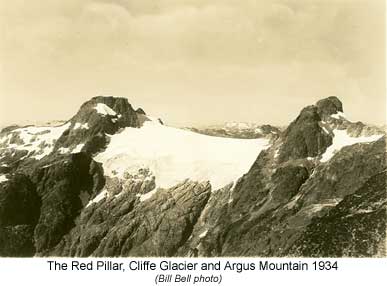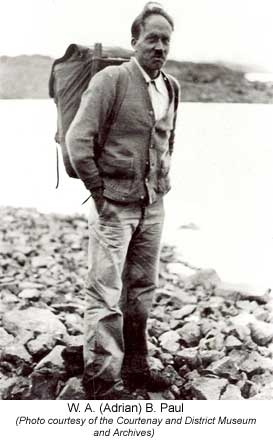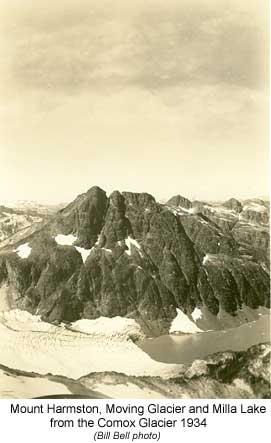Island Stories:
![]() Danzig
Mine
Danzig
Mine
![]() Zeballos
Iron Mine
Zeballos
Iron Mine
![]() Conuma
Peak 1910
Conuma
Peak 1910
Alexandra Peak
Argus Mountain
Bate/Alava Sanctuary
Beaufort Range
Big Interior Mtn
Big Interior Mtn 1913
Part 1
Part 2
Bolton Expedition 1896
Cliffe Glacier
Clinton Wood
Comox Glacier
Comox Glacier 1922
Comox Glacier 1925
Comstock Mtn
Conuma Peak
Copper King Mine
Crown Mtn
Elkhorn 1912
Elkhorn 1949
Elkhorn 1968
Eugene Croteau
Golden Bullets
Golden Hinde 1913/14
Golden Hinde 1937
Golden Hinde 1983
Harry Winstone Tragedy
Jack Mitchell
Jim Mitchell Tragedy
John Buttle
Judges Route
Koksilah's Silver Mine
Landslide Lake
Mackenzie Range
Malaspina Peak
Mariner Mtn
Marjories Load
Matchlee Mountain
Mount McQuillan
Mt. Albert Edward
Mt. Albert Edward 1927
Mt. Albert Edward 1938
Mt. Becher
Mt. Benson 1913
Mt. Benson
Mt. Doogie Dowler
Mt. Colonel Foster
Mt. Hayes/Thistle Claim
Mt. Maxwell
Mt. Sicker
Mt. Tzouhalem
Mt. Whymper
Muqin/Brooks Peninsula
Nine Peaks
Queneesh
Ralph Rosseau 1947
Rosseau Chalet
Ralph Rosseau Tragedy
Rambler Peak
Red Pillar
Rex Gibson Tragedy
Sid's Cabin
Steamboat Mtn
Strathcona Park 1980's
The Misthorns
The Unwild Side
Victoria Peak
Waterloo Mountain 1865
Wheaton Hut/Marble Meadows
William DeVoe
Woss Lake
You Creek Mine
Zeballos Peak
Other Stories:
Sierra
de los Tuxtlas
Antarctica
Cerro del Tepozteco
Citlaltepetl
Huascaran
Mt. Roraima
Nevada Alpamayo
Nevada del Tolima
Nevado de Toluca
Pico Bolivar
Popocatepetl
Uluru/Ayers Rock
Volcan Purace
Volcan San Jose
Biographies
Island 6000
Cartoons
Order the Book
Contact Me
Links

The Cliffe
Glacier:
And the Story of
the Surrounding Mountains
by Lindsay Elms
 From
downtown Comox a large, steep sided mountain with a reddish tinge to the
rock and a flat top can be seen to the west of the Comox
Glacier, while to the northwest can be seen a mountain with
three summits, but what can't be seen is the large glacier that these
mountains rise above. This glacier is hidden by Queneesh:
the mythical name the First Nations People have given to the Comox Glacier.
The second glacier was unnamed as were the two mountains until the early
1930's. The glacier became known as the Cliffe Glacier while the two mountains
became identified as The Red Pillar and Mount Harmston.
From
downtown Comox a large, steep sided mountain with a reddish tinge to the
rock and a flat top can be seen to the west of the Comox
Glacier, while to the northwest can be seen a mountain with
three summits, but what can't be seen is the large glacier that these
mountains rise above. This glacier is hidden by Queneesh:
the mythical name the First Nations People have given to the Comox Glacier.
The second glacier was unnamed as were the two mountains until the early
1930's. The glacier became known as the Cliffe Glacier while the two mountains
became identified as The Red Pillar and Mount Harmston.
Both the Cliffe Glacier and Mount Harmston are named after pioneering families in the Comox Valley. William and Florence Harmston arrived from England with their six-year-old daughter Florence, in 1862, as did the sixteen-year-old Samuel Cliffe. The Harmstons' settled in the valley while Cliffe initially ventured to Nanaimo, which was booming with the founding of rich coal seams. Cliffe eventually moved to Cumberland and in 1873 he married Florence Harmston.
 In
1922 Harold Banks led the first trip from the Comox Valley to the Comox
Glacier (1922) that included in its party Alfred McNevin, James
Tremlett, and Reverend George Kinney. From the glacier they continued
north on to the Aureole Snowfield where they climbed Iceberg Peak and
Mount Celeste, and then descended down Shepherds Creek to Buttle Lake.
Although they saw the Cliffe Glacier from the Comox Glacier they never
ventured on to it on this trip. It wasn't until August 1931, that W.A.B.
(Adrian) Paul of Comox, decided to led a trip to the virgin peak at the
southern end of the Cliffe Glacier that he believed was several hundred
feet high than "The Dome." Joining the party from Nanaimo was
Arthur Leighton, and from Courtenay Jack Gregson and Ben Hughes, the owner
of the Comox Argus newspaper.
In
1922 Harold Banks led the first trip from the Comox Valley to the Comox
Glacier (1922) that included in its party Alfred McNevin, James
Tremlett, and Reverend George Kinney. From the glacier they continued
north on to the Aureole Snowfield where they climbed Iceberg Peak and
Mount Celeste, and then descended down Shepherds Creek to Buttle Lake.
Although they saw the Cliffe Glacier from the Comox Glacier they never
ventured on to it on this trip. It wasn't until August 1931, that W.A.B.
(Adrian) Paul of Comox, decided to led a trip to the virgin peak at the
southern end of the Cliffe Glacier that he believed was several hundred
feet high than "The Dome." Joining the party from Nanaimo was
Arthur Leighton, and from Courtenay Jack Gregson and Ben Hughes, the owner
of the Comox Argus newspaper.
Ben Wallace Hughes was born in Croxall, Derbyshire, England in 1887 and was later educated in Strafford-on-Avon, at the grammar school Shakespeare once attended, a fact that may have inspired his love of writing. Hughes began an apprenticeship in electrical engineering but soon abandoned this for journalism. In 1903 Hughes and a friend traveled out to North America where he began work on a railway survey gang in New Mexico and then at the mines in Cobalt. He made a name for himself as a mining reporter and became the editor of Cobalt's Daily Nugget. He quit when asked to support the Conservative Party in the periodical as he advocated independent journalism. Hughes then went on to found the Northern Miner, which is now one of the largest mining newspapers in the world.
In 1916 he sold the Northern Miner and joined the army, serving overseas with the Royal Canadian Engineers until the end of the war. After the war he headed west to Vancouver Island and made his home in Comox. He bought the two year old Comox Argus and founded the West Coast Advocate in Port Alberni, and the short lived Parksville News, but eventually settled down to focus solely on the Argus. Hughes sold the Comox Argus in 1955 when he retired after thirty-six years as its publisher, but continued writing and published the History of the Comox Valley: 1862 to 1945. He founded the Courtenay and District Historical Society and served as secretary to the Chamber of Commerce. In 1970, at the age of eighty-seven, Ben Hughes passed away but his name has not been forgotten and he is remembered as a businessman/writer and pioneer of the mountains in the Forbidden Plateau.
In July 1928 Ben Hughes went in to Forbidden Plateau on an Alpine Club of Canada camp. Included on the trip was Claude Harrison, the president of the Vancouver Island section of the Alpine Club of Canada and Courtenay's Sid Williams. A party of twenty-eight climbed Mount Albert Edward and then the following day Hughes climbed Castle Mountain (Castlecrag) with eight others making the first ascent of this peak. Adrian Paul was amongst the party; however, he only climbed Mount Albert Edward. Both Ben Hughes and Adrian Paul then went on and climbed the Comox Glacier with Geoffrey Capes and two others in 1929; and in August 1930, Paul, along with David Guthrie and Henry Ellis, climbed Alexandra Peak for the first time as part of a four-day trip from Circlet Lake. While on Alexandra Peak they climbed The Thumb, a steep little rock tower that on two sides is either sheer or overhanging. Although these men undertook numerous other excursions into the mountains, the one that they are best remembered for is the trip into the Cliffe Glacier in July 1931 whereby they climbed The Red Pillar.
Their trip began by following the usual route up to Comox Lake and Forbush Lake but instead of climbing over Mount Evans (Kookjai Mountain), they continued up the Puntledge River to a river flowing down from the glaciers (Red Pillar Creek.) They fought their way through the Devil's Club and Slide Alder to a ridge that led up to the Cliffe Glacier and the mountain they called "The Pillar," which they hoped to climb. By lunch on the second day they had reached open ground near the toe of the Cliffe Glacier. "The Pillar" was close at hand, looking as formidable on close inspection as from the Comox Glacier.
Early Sunday morning the four attacked the reddish mass of rock via the North Face but this was soon found to be impregnable so they next sought a way up the steep West Face. A chimney was found that was difficult and in places blocked by chock stones but the climbers struggled with the rock, making every handhold count. After several hazardous moves the summit was finally gained and the climbers were able to relax. The summit was a large flat plateau with a snowfield of several acres. The only sign of life was a Ptarmigan and her famil, no doubt surprised and startled by the sight of these first humans. A rock cairn was built and a record left with a recommendation that the peak be called The Pillar.
It was a beautiful Vancouver Island summer day and the climbers lingered on the summit enjoying the spectacular views. To the west lay the mountains of Strathcona Park and in the valleys below lakes shimmered in the midday sun, beckoning the climbers down for a cool, refreshing swim.
It was time to leave the summit. The climb up the West face had been so difficult that a new route was attempted down the South Face. A route that was not quite so precipitous was found but it turned out to be more tedious. After descending, they traversed around the mountain and then crossed the Cliffe Glacier to the base of a mountain they called The Camel. They were hoping to find a way over this and onto the Comox Glacier but they found the climbing too dangerous. Initially they climbed over difficult scree slopes but a point was reached where they had to cross a thirty-foot wide snow slope. They were about five hundred feet above the glacier and on snow that they considered to be at an angle of sixty degrees. Without rope or ice axes, and with heavy packs, they made a decision to return the way they had come and reluctantly turned around and retraced their steps.
Once back in Courtenay the climbers suggested that the peak they failed on should be called The Camel. However, in 1934 when Norman Stewart, a British Columbia Land Surveyor, came to consult the local mountaineers about the nomenclature of the peaks and other prominent points in the area of Forbidden Plateau and Strathcona Park, he said there were numerous "Camel" mountains already in Canada. Stewart suggested that it should be called Ben Hughes Mountain but the proprietor of the Argus objected to this on the grounds that it was too personal, but agreed that it should be named after the paper he owned, and so it was. Stewart was also able to confirm that the Pillar Mountain be called The Red Pillar because of its characteristic colour and shape.
The second ascent of The Red Pillar occurred during the summer of 1934. William Moffat, a British Columbia Land Surveyor who emigrated from Ireland in 1912, was involved with the survey of the mountains with Norman Stewart, and while undertaking topographical surveys climbed the mountain before it was officially named The Red Pillar. Moffat suggested that it be called Mount Esther, the Christian name of an American woman who had been in the area of the glaciers that year with a party led by Harold Cliffe. This name did not receive much attention and was quickly dropped.
 The
failure by Hughes, Leighton, Paul and Gregson on Argus
Mountain in 1931 led other mountaineers to believe that it
was harder to climb then The Red Pillar and it was many years before it
was attempted again. An article in the Comox Argus from July 6, 1949,
states that over the Dominion Day weekend, Argus
Mountain received its first ascent by Alex and William (Bill) Bell
of Courtenay. Bill was familiar with the glacial area, as he had undertaken
numerous trips into the region while working for the surveyors in the
1930's. The Bell Brothers took the usual route into the Comox Glacier
and camped on a rock ledge between the glacier and Argus Mountain. On
July 2, they climbed a long, steep gully that took them to a col between
the two summits. The ascent was easier then they had anticipated but they
used the rope to be safe as a fall could be fatal. The brothers returned
triumphant having believed they had climbed the last unclimbed mountain
around the two glaciers. However, this may not be quite true.
The
failure by Hughes, Leighton, Paul and Gregson on Argus
Mountain in 1931 led other mountaineers to believe that it
was harder to climb then The Red Pillar and it was many years before it
was attempted again. An article in the Comox Argus from July 6, 1949,
states that over the Dominion Day weekend, Argus
Mountain received its first ascent by Alex and William (Bill) Bell
of Courtenay. Bill was familiar with the glacial area, as he had undertaken
numerous trips into the region while working for the surveyors in the
1930's. The Bell Brothers took the usual route into the Comox Glacier
and camped on a rock ledge between the glacier and Argus Mountain. On
July 2, they climbed a long, steep gully that took them to a col between
the two summits. The ascent was easier then they had anticipated but they
used the rope to be safe as a fall could be fatal. The brothers returned
triumphant having believed they had climbed the last unclimbed mountain
around the two glaciers. However, this may not be quite true.
Nowadays, Argus Mountain can be climbed as a long day trip, by fit climbers,
from a camp at the Frog Ponds east of Blackcat Mountain; however, ascents
are made easier in the spring/early summer before moats form at the bottom
of the steep snow gully. The Red Pillar and Mount Harmston are different
propositions because of their location, and usually require more time.
Although the two glaciers are not difficult, it is important to have a
rope and for the climbers to be proficient in its use. Crevasses can remain
hidden by last season's snow cover or freshly fallen snow, and as has
been seen around the world, they can be a deadly for both the uninitiated
and the experienced. The local glaciers are no exceptions. However, the
effort required by mountaineers to get to the Cliffe Glacier and the surrounding
mountains is worth the toil when one sees the incredible views of both
the Comox and Alberni Valleys, and the mountains of Strathcona Park.
How to order | | About the Author || Links || Home
Contact:
Copyright ©
Lindsay Elms 2001. All Rights Reserved.
URL: http://www.beyondnootka.com
http://www.lindsayelms.ca